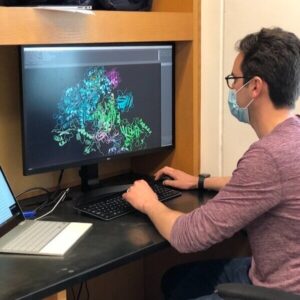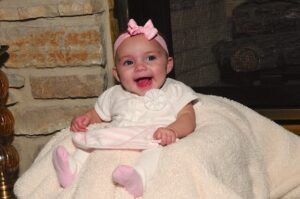Many scientists venture out with a desire to make a mark on a field. Many succeed with papers, patents and products. But few get the chance to impact a person directly, and fewer still, a person in one’s own family.
Postdoctoral researcher James Bowman, PhD, at the Institute for Protein Innovation, did just that with a collaboration to study a rare and elusive disease.
Affecting only about 1 in 80,000 newborns, Shwachman-Diamond syndrome is inherited and marked by a failure to thrive, pancreatic deficits and bone marrow failure. Its symptoms, like poor growth and fevers, typically appear in infants by four to six months of age. With treatment and regular monitoring, children with SDS can lead fulfilling lives. However, five percent will develop leukemia, with the risk rising to 30 percent of patients by 30 years of age.
“It’s horrible to watch these children develop cancer,” says pediatric oncologist Alyssa Kennedy, MD, PhD, at Dana-Farber/Boston Children’s Cancer and Blood Disorders Center. She joined the laboratory of pediatric hematologist Akiko Shimamura, MD, PhD, “to figure out what can help predict who goes on to develop leukemia and why.”
Shimamura had spent 20 years painstakingly building a registry of blood and bone marrow samples from SDS patients of all ages. “I realized that there are certain mechanistic questions you can ask in the laboratory,” Shimamura says. “But if you really want to understand the disease, you have to partner with the patients.”
Joining forces with Coleman Lindsley, MD, PhD, an expert in genomic analysis at Dana-Farber Cancer Institute, Kennedy and Shimamura began to probe the genetic mutations that drove specific stem cells to develop into cancer-prone cells.
Mutation after Mutation
Most SDS patients carry mutations in their SBDS genes, which normally provide cells with the instructions for producing a critical protein that assembles cell structures called ribosomes. Made up of two parts, or subunits, ribosomes carry out the vital function of making proteins. The SBDS protein preps the ribosome’s large subunit by removing another protein called EIF6 that caps the subunit and prevents its interaction with the small subunit.
“SBDS is almost like a little bottle opener that kicks off the bottle top (EIF6) to get what you want,” says Kennedy, “which is the mature ribosome.”
When the gene is mutated, as in Shwachman-Diamond syndrome, the ribosomal subunits remain “capped,” immature and unable to make proteins. The result is a body-wide defect in stem cells that shows up in patients as bone marrow failure, among other symptoms.
What the Boston Children’s team learned, and perhaps the most fascinating aspect of this biochemical story, is that stem cells are resilient. To survive SDS, they acquire more mutations, one set of which can reverse the defect. These rescue mutations arise early in an infant with SDS and most commonly in the capping gene, EIF6. In 110 patients studied, the investigators identified 265 EIF6 mutations that arose after their primary SBDS mutations.
These mutations came in two flavors. The first stopped the production of EIF6 before the cell could finish making it, leading to a shortened stub of a capping protein. Lacking the cap on the large subunit, it could once again join its smaller partner and make a functional ribosome. In other words, the second mutation (EIF6) reversed the damage of the first (SBDS).
The second type of mutation, called a missense mutation, introduced an error in the EIF6 code. It allowed the full-length SBDS protein to form, albeit with an anomaly. What was the defect, and how did it rescue the SDBS mutation that marked the disease?
For answers, Shimamura approached IPI’s Chris Bahl, a protein structure and design expert whose laboratory was located, literally, down the street. Shimamura believed Bahl might help her by deploying a computational approach to ascertain what the mutant EIF6 proteins were doing to fix ribosome assembly.

All in the Family
On the day that Shimamura discussed her goals with Bahl, Bowman was working in the tissue culture room. Unbeknownst to Shimamura or Bahl, Bowman had a cousin, Annabel, who had been born with a “mystery illness that nobody could really figure out.” Annabel’s father (Bowman’s uncle and godfather) had Googled the girl’s symptoms, such as failure to thrive. He came up with a rare genetic disease, Shwachman-Diamond syndrome. It bore a striking overlap with Annabel’s symptoms.
Initially, the doctors were skeptical: “everybody Googles stuff and thinks they have things figured out,” Bowman concedes. But a subsequent genetic test confirmed that Annabel did indeed have SDS. Even more uncanny, Annabel, who lives in Seattle, became a patient of Shimamura, who later moved from Seattle Children’s to Boston Children’s Hospital.
And now, Shimamura was standing in Bahl’s lab looking for a computational protein engineer, which Bowman was, to help her unravel the mystery of the rescue EIF6 proteins. Bowman quickly realized that Shimamura’s registry contained his cousin’s tissue samples, albeit carefully de-identified. That meant by participating in this study, Bowman would directly impact Annabel’s life.
“It was just crazy how serendipitous and how small of a world Boston science is,” he says. “Without even searching, you get an opportunity like this.”
Under the guidance of Bahl, Bowman created a model of EIF6 protein using similar known structures from yeast, slime mold and archaebacteria. Through computer modeling, he learned that the EIF6 missense mutations affected protein function in two ways. One destabilized the protein, making the “cap” too flimsy to prevent ribosomal subunit joining. The other impaired its binding to the large subunit, making it too loose to hold on.

The results, recently published in Nature Communications, illuminated a new direction for therapy, currently relegated to bone marrow transplant. If the team could find agents that mimic the genetic crippling of EIF6, making a patient’s caps too flimsy or loose, investigators could help treat the disease and prevent its other, more sobering consequence: cancer.
Preventing Cancer
When ribosomal joining is impaired, cells respond by activating a stress pathway that involves the tumor suppressor p53. In essence, p53 prevents damaged cells from reproducing or forces them to commit cell suicide. In SDS, EIF6 mutations rescue the ribosome assembly defect, spurring improved stem cell production. At the same time, EIF6 mutations are not associated with the conversion of SDS into cancer. Something else is the culprit.
Through genetic studies, Kennedy found that “something else” is the second most common crop of mutations that occur in SDS patients: those in the TP53 gene, which encodes the p53 protein that controls cell division and survival. Mutations in TP53, like EIF6, initially rescue cell growth and reproduction. Unlike EIF6, however, TP53 mutations fail to improve ribosome assembly and can be found in patients’ blood-producing stem cells when leukemia develops.
All humans have two copies of any gene, one maternal and the other paternal. Kennedy observed that patients had to acquire mutations in both copies of TP53 for blood-producing cells to become cancerous. She could detect that malignant transition several years before the development of leukemia. Thus, testing for these so-called “bi-allelic mutations” might identify patients at high risk of leukemia; they might benefit from early intervention with a bone marrow transplant.
Another key finding was that TP53 mutations were not observed in cells that had acquired EIF6 mutations. This suggests that correcting the SDS defect with EIF6 therapy might keep stem cells fitter for longer. Their risk of developing cancer-causing TP53 mutations would diminish because the SDS defect had already been rescued by EIF6 alteration.
Confused? Shimamaura, citing a colleague, explains it this way: an SBDS mutation is like blowing the transmission on a car (the stem cells) that should be motoring down the highway (making proteins). Adding in a TP53 mutation revs the car back up but tragically drives it off the road into a cancer ditch. By contrast, EIF6 mutations keep the car going and on the highway. By promoting the good repair via EIF6 therapy, the cells bypass the bad one, TP53.
“This is really exciting,” Shimamura says. “We actually have a target that we can try to develop into a novel therapeutic for bone marrow failure that also prevents leukemia.
The impact would be large not only for Kennedy and Shimamura, who see SDS patients in the clinic, but also for Bowman, who knows one so intimately.
“It just makes you realize that for every disease-relevant target, there’s somebody else with a story,” says Bowman. “And it matters a lot to them to have somebody who can do the science to improve their quality of life.”


